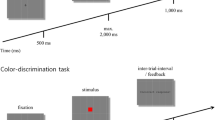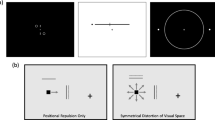Abstract
Simple reaction time to visual stimuli depends on several stimulus properties. Recently, converging evidence showed that larger stimulus size evokes faster reactions and that this effect seemingly depends on the stimulus’ perceived size rather than on physical stimulus properties. Size–distance scaling usually is regarded as the main functional mechanism underlying size perception. Yet, the role of stimulus depth (distance to a target) has often been neglected in previous studies. Hence, in the present investigation, stimuli were generated using stereo head mounted displays to manipulate stimulus depth. In Experiment 1, a large or small target was presented within the center of a reference plane, either in the same depth plane or displaced (near, far) while participants had to perform a simple reaction time task. At the same time, the target was modulated such that either retinal size was constant or variable across depth planes. In Experiments 2 and 3 the reference plane was shifted along with the target (blocked or on a trial-by-trial basis), while retinal size modulation was equal to Experiment 1. As expected, participants reacted faster to physically larger targets. Also Experiment 1 revealed faster reaction times for closer targets, while the commonly described connection between perceived size (i.e., size–distance scaling) was not apparent in any experiment. Thus, unlike past findings using a virtual three-dimensional task-setting (as induced by binocular disparity) reaction times are not affected by variations of perceived stimulus size.




Similar content being viewed by others
References
Bakeman, R. (2005). Recommended effect size statistics for repeated measures designs. Behavior Research Methods, 37, 379–384.
Balota, D. A., & Yap, M. J. (2011). moving beyond the mean in studies of mental chronometry the power of response time distributional analyses. Current Directions in Psychological Science, 20, 160–166.
Blake, R., Sloane, M., & Fox, R. (1981). Further developments in binocular summation. Perception and Psychophysics, 30, 266–276.
Broggin, E., Savazzi, S., & Marzi, C. A. (2012). Similar effects of visual perception and imagery on simple reaction time. Quarterly Journal of Experimental Psychology (2006), 65, 151–164.
Cattell, J. M. (1886). The influence of the intensity of the stimulus on the length of the reaction time. Brain, 8, 512–515.
Caziot, B., & Backus, B. T. (2015). Stereoscopic Offset Makes Objects Easier to Recognize. PLoS ONE, 10, e0129101.
Chen, Q., Weidner, R., Vossel, S., Weiss, P. H., & Fink, G. R. (2012). Neural mechanisms of attentional reorienting in three-dimensional space. The Journal of Neuroscience, 32, 13352–13362.
de Gawryszewski, L. G., Riggio, L., Rizzolatti, G., & Umiltá, C. (1987). Movements of attention in the three spatial dimensions and the meaning of “neutral” cues. Neuropsychologia, 25, 19–29.
Dent, K., Braithwaite, J. J., He, X., & Humphreys, G. W. (2012). Integrating space and time in visual search: how the preview benefit is modulated by stereoscopic depth. Vision Research, 65, 45–61.
Downing, C. J., & Pinker, S. (1985). The Spatial Structure of Visual Attention. In M. I. Posner & O. S. Marin (Eds.), Mechanisms of Attention: Attention and Performance XI (pp. 171–187). Hillsdale: Erlbaum.
Epstein, W., Park, J., & Casey, A. (1961). The current status of the size-distance hypotheses. Psychological Bulletin, 58, 491–514.
Finlayson, N. J., & Grove, P. M. (2015). Visual search is influenced by 3D spatial layout. Attention, Perception, & Psychophysics, 77, 2322–2330.
Finlayson, N. J., Remington, R. W., & Grove, P. M. (2012). The role of presentation method and depth singletons in visual search for objects moving in depth. Journal of Vision, 12, 13.
Franconeri, S. L., & Simons, D. J. (2003). Moving and looming stimuli capture attention. Perception and Psychophysics, 65, 999–1010.
Gilliland, K., & Haines, R. F. (1975). Binocular summation and peripheral visual response time. American Journal of Optometry & Physiological Optics, 52, 834–839.
Goldstein, E. (2013). Sensation and perception. Cengage Learning.
Gregory, R. L. (1963). Distortion of Visual Space as Inappropriate Constancy Scaling. Nature, 199, 678–680.
Gregory, R. L. (1997). Knowledge in perception and illusion. Philosophical Transactions of the Royal Society B: Biological Sciences, 352, 1121–1127.
Grubbs, F. E. (1969). Procedures for Detecting Outlying Observations in Samples. Technometrics, 11, 1–21.
Jainta, S., Blythe, H. I., & Liversedge, S. P. (2014). Binocular Advantages in Reading. Current Biology, 24, 526–530.
Knapp, J. M., & Loomis, J. M. (2004). Limited Field of View of Head-Mounted Displays Is Not the Cause of Distance Underestimation in Virtual Environments. Presence: Teleoperators and Virtual Environments, 13, 572–577.
Lacouture, Y., & Cousineau, D. (2008). How to use MATLAB to fit the ex-Gaussian and other probability functions to a distribution of response times. Tutorials in Quantitative Methods for Psychology, 4, 35–45.
Luce, R. D. (1986). Response Times. Oxford University Press.
Marzi, C. A., Mancini, F., Metitieri, T., & Savazzi, S. (2006). Retinal eccentricity effects on reaction time to imagined stimuli. Neuropsychologia, 44, 1489–1495.
Matzke, D., & Wagenmakers, E.-J. (2009). Psychological interpretation of the ex-Gaussian and shifted Wald parameters: a diffusion model analysis. Psychonomic Bulletin & Review, 16, 798–817.
Morey, R. D. (2008). Confidence intervals from normalized data: A correction to Cousineau (2005). Tutorial in Quantitative Methods for Psychology, 4(2), 61–64.
Murgia, A., & Sharkey, P. M. (2009). Estimation of distances in virtual environments using size constancy. The International Journal of Virtual Reality, 8, 67–74.
Murray, S. O., Boyaci, H., & Kersten, D. (2006). The representation of perceived angular size in human primary visual cortex. Nature Neuroscience, 9, 429–434.
Naceri, A., Chellali, R., Dionnet, F., & Toma, S. (2010). Depth perception within virtual environments: comparison between two display technologies. International Journal On Advances in Intelligent Systems, 3, 51–64.
Neri, P., Bridge, H., & Heeger, D. J. (2004). Stereoscopic processing of absolute and relative disparity in human visual cortex. Journal of Neurophysiology, 92, 1880–1891.
Oldfield, R. C. (1971). The assessment and analysis of handedness: the Edinburgh inventory. Neuropsychologia, 9, 97–113.
Olejnik, S., & Algina, J. (2003). Generalized eta and omega squared statistics: measures of effect size for some common research designs. Psychological Methods, 8, 434–447.
Parker, A. J. (2007). Binocular depth perception and the cerebral cortex. Nature Reviews Neuroscience, 8, 379–391.
Parks, N. A., & Corballis, P. M. (2006). Attending to depth: electrophysiological evidence for a viewer-centered asymmetry. NeuroReport, 17, 643–647.
Plewan, T., Weidner, R., & Fink, G. R. (2012). The influence of stimulus duration on visual illusions and simple reaction time. Experimental Brain Research, 223, 367–375.
Ponzo, M. (1928). Urteilstäuschungen über Mengen. Archiv Für Die Gesamte Psychologie, 65, 129–162.
Ratcliff, R. (1993). Methods for dealing with reaction time outliers. Psychological Bulletin, 114, 510–532.
Renner, R. S., Velichkovsky, B. M., & Helmert, J. R. (2013). The Perception of Egocentric Distances in Virtual Environments - A Review. ACM Computing Surveys, 46, 23:1–23:40.
Ross, H. E., & Plug, C. (1998). The history of size constancy and size illusions. In V. Walsh & J. Kulikowski (Eds.), Perceptual Constancy: Why Things Look as they Do (pp. 499–528). Cambridge: Cambridge University Press.
Savazzi, S., Emanuele, B., Scalf, P., & Beck, D. (2012). Reaction times and perceptual adjustments are sensitive to the illusory distortion of space. Experimental Brain Research, 218, 119–128.
Schiffman, H. R. (1967). Size-Estimation of Familiar Objects under Informative and Reduced Conditions of Viewing. The American Journal of Psychology, 80, 229–235.
Shulman, G. L., Remington, R. W., & McLean, J. P. (1979). Moving attention through visual space. Journal of Experimental Psychology: Human Perception and Performance, 5, 522–526.
Slack, C. W. (1956). Familiar size as a cue to size in the presence of conflicting cues. Journal of Experimental Psychology, 52, 194–198.
Sperandio, I., Chouinard, P. A., & Goodale, M. A. (2012). Retinotopic activity in V1 reflects the perceived and not the retinal size of an afterimage. Nature Neuroscience, 15, 540–542.
Sperandio, I., Savazzi, S., Gregory, R. L., & Marzi, C. A. (2009). Visual reaction time and size constancy. Perception, 38, 1601–1609.
Sperandio, I., Savazzi, S., & Marzi, C. A. (2010). Is simple reaction time affected by visual illusions? Experimental Brain Research, 201, 345–350.
Teichner, W. H., & Krebs, M. J. (1972). Laws of the simple visual reaction time. Psychological Review, 79, 344–358.
Theeuwes, J., Atchley, P., & Kramer, A. F. (1998). Attentional control within 3-D space. Journal of Experimental Psychology: Human Perception and Performance, 24, 1476–1485.
Ulrich, R., Rinkenauer, G., & Miller, J. (1998). Effects of stimulus duration and intensity on simple reaction time and response force. Journal of Experimental Psychology Human Perception and Performance, 24, 915–928.
Wakayama, A., Matsumoto, C., Ohmure, K., Inase, M., & Shimomura, Y. (2011). Influence of target size and eccentricity on binocular summation of reaction time in kinetic perimetry. Vision Research, 51, 174–178.
Weidner, R., Plewan, T., Chen, Q., Buchner, A., Weiss, P. H., & Fink, G. R. (2014). The Moon Illusion and Size-Distance Scaling—Evidence for Shared Neural Patterns. Journal of Cognitive Neuroscience, 26, 1871–1882.
Whelan, R. (2010). Effective analysis of reaction time data. The Psychological Record, 58, 475–482.
Author information
Authors and Affiliations
Corresponding author
Rights and permissions
About this article
Cite this article
Plewan, T., Rinkenauer, G. Simple reaction time and size–distance integration in virtual 3D space. Psychological Research 81, 653–663 (2017). https://doi.org/10.1007/s00426-016-0769-y
Received:
Accepted:
Published:
Issue Date:
DOI: https://doi.org/10.1007/s00426-016-0769-y




